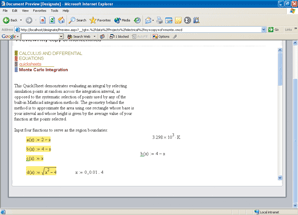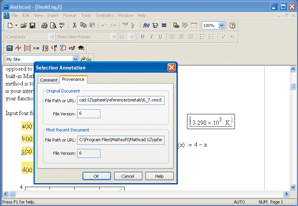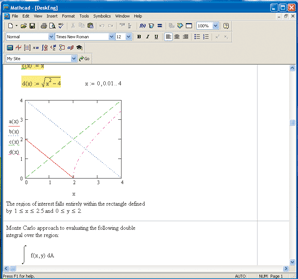December 1, 2004
By Barry Simon
Mathsoft, developer of Mathcad, claims that more engineers use its program thanany other high-end mathematical package. Since all these products are from privatelyowned companies, it is hard to confirm this data, but it’s safe to say Mathcadhas more users in industry than the major competing products: Maple, Mathematica,and Matlab. In any event, the release of the $1,200 Mathcad 12.0 is of significantinterest to many engineers and other technical professionals.
Basic Interface Remains Unchanged
Mathcad’s basic look and capabilities are unchanged. Documents can contain textregions, equation regions, and plots with the capability of embedding equationsand plots into text regions. Like a spreadsheet, if you change the value of anyvariable in a Mathcad worksheet, the change is immediately reflected in all locationson the worksheet that reference that variable.
|
|
|
Tutorial worksheets that are provided with the software package help simplifythe learning process, and reference files provide users with access to oodlesof formulae and physical data (such as melting points) that can be copied andpasted into worksheets.

Above: A module called Designate allows you to get a listing of all the annotationsin a file and acts a search function.
A Switch to XML
The most significant change in Mathcad 12 is the shift from aproprietary file format to one based on XML and the resultingflexibility this change allows. This means that Mathsoft has developedits own schema to specify exactly how data is stored in Mathcad filesin a format readable by XML programmers. It also allows third partiesand in-house programmers to manipulate Mathcad files for all sorts ofpurposes. While the specification is publicly available it is exclusiveto Mathsoft and not based on the MathML specification (a translator toMathML is currently in the works).
Mathcad 12 includes—or makes available via a thirdparty—translation tools to XHTML that allow browser viewing as well asto XMLFO that allow translation to the Acrobat format.
The Metadata Enhancements
XML specifications typically allow the inclusion ofmetadata—information not normally displayed that is available to XMLparsers or for selected display by programs. The new Mathcad files makerich use of this capability. First, files now have a properties sheetthat includes items like author name. And you can add custom fieldsthat automatically display a project name, or employee number or namein the property sheet.
An impressive feature is the new ability to add a comment to any piece of text,full equation, part of an equation, or a graphic. For example, the electronicreference books shipped with Mathcad now have comments identifying the sourceof a given physical constant. Someone producing documents for others could placea comment explaining their assumptions behind the choice of an equation or valueof some constant. And the comments travel: If you copy and paste a region withan attached comment to another document or location within a document, the commentmoves with the region. Moreover, a new tab labeled Provenance has been added tothe annotation dialog listing the original source of the data as well as the mostrecent. In this way companies can produce audit trails for their calculations.

A user can view Mathcad files in a browser if the server has Designate.
Designate Opens Web Readership
A module enabling the display of Mathcad-related information on intranets orover the Internet called Designate is included in Mathsoft’s Calculation ManagementSuite. It runs as a module under IIS (Microsoft’s Web Server) and allows displayof Mathcad documents on the Internet readable by anyone who visits the website.Designate also displays company-wide collections of Mathcad files that can beorganized in folders, and then displayed as HTML files or edited in Mathcad. Userscan also display a list of all annotations in any file and search on content includingannotations across the entire set of Designate documents. Prices start at $15,000for 10 seats, including two days of training for those who will manage the program.
With Designate and the annotation capabilities of Mathcad, enterprise-wide managementof calculations is possible.
Other Enhancements Expand Functionality
At long last, users can use separate left-hand and right-hand y axes to permitcomparative graphing of functions with different scales. It’s an ability thatstand-alone scientific graphing programs have had for quite awhile and has beenlong sought after by Mathcad users.

Annotations include tracking the original source file for a piece of informationthat was cut and pasted from another location.
While Mathcad has had built-in sets of units like MKS for a number of years,it is now possible to modify them. (Though it might not be wise to replace meterswith feet, it might make sense to replace meters with decimeters.) There are severalnew and improved functions including various correlation functions and scaledAiry functions (the ability to time long calculations and to generate vectorsof logarithms).
Mathcad now lets the user add what it calls web controls, but which are actuallystandard windows dialog controls like drop-down menus. This gives the user theability to prepare a worksheet that includes a menu of variables for others touse. That variable value will then propagate throughout the sheet.
A Winner for Simplicity and Management
While potential users can choose between Maple, Mathcad, Mathematica, and Matlab,the case could be made that Mathcad is in a category all its own. Mathcad allowssome simple user developed programs and allows for automated links to other programslike Excel, but it doesn’t let users write full-blown programs the way its competitorsdo. On the other hand, because it doesn’t use the command line interface as itsbasic mode of input, it is by far the simplest math product to use. While Mathematicahas added features like the ability to enter integrals using integral signs ratherthan an arcane command and Mathcad continually adds higher mathematics, the basicadvice about choosing a math product is the same as it was 10 years ago: If youneed certain high-end mathematics or if you need sophisticated, even recursive,programs, pick a competitor, but if Mathcad meets your math needs, choose it forits simplicity. And now, it is also the choice for enterprise-wide calculationmanagement.
Contributing Editor Barry Simon is chairman of the math department at the California Institute of Technology.You can send him your thoughts about this article via e-mail c/o [email protected].
Product & Company Information
Mathcad 12.0Price:$1200
Requires: 100MB disk space, 128MB RAM, Windows 2000 SP4 or XP
Mathsoft Engineering and Education
Cambridge, MA
mathsoft.com
Subscribe to our FREE magazine, FREE email newsletters or both!
About the Author
DE’s editors contribute news and new product announcements to Digital Engineering.
Press releases may be sent to them via [email protected].







